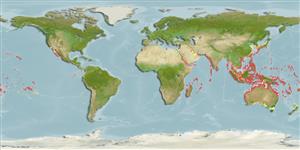Common names from other countries
Environment: milieu / climate zone / depth range / distribution range
Ecologia
; intervalo de profundidade 10 - 30 m (Ref. 337). Tropical
Indo-Pacific.
Length at first maturity / Tamanho / Peso / Idade
Maturity: Lm ? range ? - ? cm Max length : 8.0 cm SHL macho/indeterminado; (Ref. 349); common length : 6.5 cm SHL macho/indeterminado; (Ref. 349)
Collected by coastal populations in the tropical West Pacific for food and shell trade (Ref. 349). Often very common (Ref. 349). Found at depths of 10 to 30 m, on alga-covered rock (Ref. 337), and on coral reef flats on coral atolls and in tide pools on thin alga-sand bottom (Ref. 87884).
Life cycle and mating behavior
Maturidade | Reprodução | Desova | Ovos | Fecundidade | Larvas
Members of the order Neotaenioglossa are mostly gonochoric and broadcast spawners. Life cycle: Embryos develop into planktonic trocophore larvae and later into juvenile veligers before becoming fully grown adults.
Poutiers, J.M. 1998. (Ref. 349)
Status na Lista Vermelha da IUCN (Ref. 130435)
Status no CITES (Ref. 108899)
Not Evaluated
Not Evaluated
Perigo para os humanos
Harmless
Uso pelos humanos
Pescarias: espécies comerciais
| FishSource |
Ferramentas
Mais informação
Idade/TamanhoCrescimentoComprimento-pesoComprimento-comprimentoMorfologiaLarvasAbundância
Fontes da internet
Estimates based on models
Preferred temperature
(Ref.
115969): 23.8 - 29, mean 27.8 (based on 432 cells).
Vulnerabilidade
Low vulnerability (10 of 100).
Categoria de preço
Unknown.
